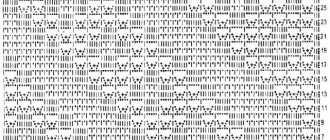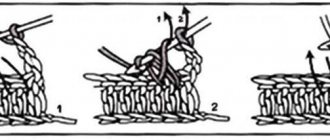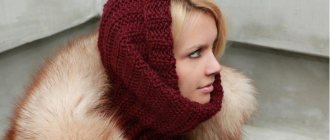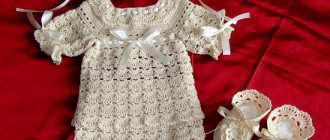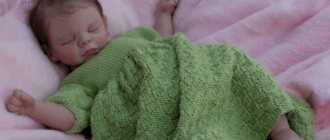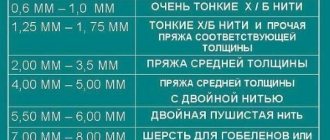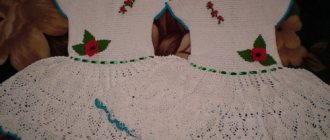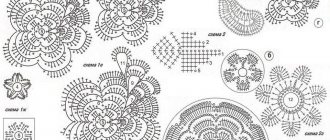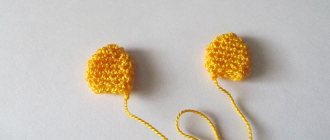Crocheted blouses for newborns from natural yarn have always enjoyed well-deserved success. Why? Because their production requires much less time than knitting, and learning to knit with this device is much easier. Some will say that things made with crochet do not have the same softness and elasticity as knitted items. But that's not true. It all depends on the knitting method, the chosen yarn and the skill of the needlewoman. Let's look at several options with which crocheting blouses for newborns will turn into an exciting activity for you, and the result will meet the highest requirements for children's clothing. Where to start? It is best if this is the simplest option. But don’t be upset, simple doesn’t mean ugly. Below is a detailed description of the model for a boy, which looks very gentle, stylish and original.
Crochet blouse for newborn boy
This sweater is a universal model. Just change the blue color to pink, and it will easily turn into clothes for a little princess.
Despite the fact that this jumper looks very elegant, even a novice needlewoman can knit it. The main knitting pattern is double crochet, the finishing of the neck and bottom edge of the product is single crochet. The applique on the sweater can be anything. In this case it is the crown.
If you want to knit such a sweater for very young children, you can make an additional fastener on the shoulder or at the back. This will make the process of dressing your child easier. Crocheted blouses for newborns, made taking into account all the rules, must first of all meet the requirements of convenience and comfort.
Blouse for girls
An outfit for a girl is always different from a similar one for a boy, and this must be understood immediately. The main thing that needs to be taken care of when starting knitting is, first of all, in addition to beauty, it is convenience. Clothing should provide comfort and not restrict the child’s movement. It is best for babies to choose blouses with buttons to make the process of putting on and taking off easier.
Openwork models of things are perfect for girls. Linking them is not so difficult if you follow all the rules. It is best to choose a plain soft yarn and stick to an even knit, then the pattern will be the most delicate and attractive. A blouse for a newborn girl is always a festive outfit, no matter what pattern was used for knitting.
The choice of yarn and color can be absolutely anything based on personal preference.
If you are still in doubt about whether you should start knitting a blouse for a newborn baby, it is worth noting that such things have a lot of advantages, for example:
- The crocheted item has a delicate appearance. Such wardrobe items look very cute, especially on girls. If the item is made for warm weather, it will be very openwork and airy;
- When a blouse is crocheted, it has a minimum of seams, which is very useful for the child and will not cause him discomfort;
- In order to start knitting, you don’t need a lot of money or special knowledge; you can learn everything very quickly, even if you’ve never knitted anything before. The jacket will be original in any case because it is created with your own hands .
Yarn selection
When choosing yarn, you need to be very careful; it should not only be attractive in appearance, but also of high quality.
It is worth paying attention to the following details:
- Yarn composition - the most suitable threads are made of cotton, wool, silk or viscose;
- To make the item last for a long time, you can add just a little synthetics;
- If you need to knit clothes for the warm season, it is better to use cotton yarn;
- Wool threads are ideal for winter blouses;
- Silk is a versatile yarn composition. Things made from this material can be worn at any time of the year.
Knitted blouses for newborns have always been and remain at the peak of popularity; don’t be afraid to start creating something with your own hands. The result will meet all expectations. This master class will help.
Operating procedure
In this example, the sweater is designed for ages 7-9 months. We start knitting the sweater from the back (from its lower part). To do this, you need to knit a chain of 30-40 loops and continue knitting with double crochets. Having reached the neckline, leave 15 middle stitches unknitted and continue knitting each shoulder separately. For a smooth outline of the neckline, in each front row we do not knit one outer column. We do this until the desired shoulder width is achieved.
We knit the front in the same way as the back, only the neckline will be deeper. Having finished with the back and front, we move on to knitting the sleeves. Since we did not make a cutout for the armhole on the front and back, knitting the sleeves will not be difficult. We will get a model with lowered sleeves.
Knitting a sleeve begins with a cuff, also with double crochets. To do this, we knit a chain of 10-13 air loops. After 2 cm, it is necessary to make increases on both sides of the canvas. To do this, we knit two double crochets in one loop. Before the end of the sleeve, you need to add several more times in every 3rd row. The second sleeve is knitted similarly to the first.
Even a mother who has picked up a crochet hook for the first time can make such crocheted blouses for newborns. They will be an indispensable item in a baby's wardrobe.
Example of a knitted blouse
For knitting we offer a blouse as in the photo:
As the starting material you will need yarn of two soft shades, buttons or rivets and hook No. 2.
As a rule, symbols are used to make knitted items.
- In order to make an air loop, you need to thread the hook through the bottom loop through the front wall or through the back and pull the main thread onto the hook. The loop that ends up on the hook will be air .
- To make a single crochet, you need to crochet the main thread through the loop of the bottom row and leave it on the hook. Next, pick up the thread of yarn again and knit it through the eye that is already on the hook.
- A double crochet is done like this: first, a thread is thrown onto the hook, creating a double crochet. After this, the hook, passed through the bottom loop in knitting, pulls out the thread of yarn. Then the main thread is hooked again and the resulting loop is threaded through the first two eyes on the rod. The yarn is hooked once again and the yarn is passed through the remaining two loops.
- Edge loops are located along the edges of the knitted fabric. Depending on the pattern, they can be knitted or simply removed without processing.
- The expression “cast off the loop” means that through the loop of the bottom row you need to pull the warp thread through the eye that is already hanging on the hook. This procedure must be done as many times as the loops need to be closed. Each time the main thread is passed through the subsequent loop of the bottom row.
- A regular aerial loop and lifting loops differ only in name. Essentially it's the same thing. The name is used only for clarity in describing the circuit. Lifting loops are made at the edges of the products in order to begin the next row.
Related article: DIY children's sandals
Knitting a blouse for a newborn follows this pattern:
Like any crochet, a blouse begins with making a chain of air loops. In total you need to collect 142 pieces. This will be the bottom edge of the product.
The next three loops will be ascent loops. Further knitting should be carried out in accordance with the proposed pattern No. 1:
The rows can be made different: a couple of rows in one color, the next couple in a different color. And so alternate until the end.
If you look at the pattern, you can see that at a height of 13 cm from the beginning of the fabric, the blouse is divided into several parts. The first 36 knitting stitches are left. This will be the left side of the product. The next 8 loops need to be closed off. There will be an armhole in this place. The 54 loops in the middle are left unchanged - this is the front side of the blouse, 8 loops are closed again for the second armhole. The remaining 36 loops are the right side of the product. Knitting continues on open loops. Those parts that are not yet processed can be pinned together with a pin.
It is much easier for both beginners and experienced needlewomen to make crocheted blouses with patterns. Clothing for newborns is knitted in small sizes, so if you carefully read the symbols, you can make it in a matter of hours.
First of all, the back of the product is finished. To do this, alternating colors, knit the right fabric to a height of 21 cm. 12 loops are closed. This is where the neck of the blouse will be. In the next four rows, the stitches are gradually decreased until only 15 stitches remain. After 1 cm the knitting is closed. This procedure is repeated for the left canvas.
The front part of the product is knitted to a length of 19 cm. After this, the inner 14 loops are closed, and the outer ones are gradually reduced. Loops are decreased in the next four rows up to 15 pieces. When the front part measures 23 cm, knitting is finished.
Related article: volumetric letter made from cardboard and napkins with video
Assembly and finishing of the product
We fold the finished shelf and back face to face and sew the shoulder seams. Then we sew on the sleeves. And only then we sew the sweater on the sides. The last step will be the seams on the sleeves.
Now you can move on to finishing. For this we will use single crochet stitches. We tie the bottom of the sweater, neck and cuffs in a circle with 3 rows of single crochets. In the photo, the binding is made in blue, but you can use any color you like. A knitted crown is used as an applique on the chest. If you are not yet very good at knitting, then you can use ready-made iron-on adhesives. This decor looks very impressive.
If you crochet this model of blouse for newborns, you will most likely hear enthusiastic reviews from others more than once, which, you will agree, is very pleasant.
A universal version of a blouse for a baby
Now let's look at how another version of the blouse is made, which is knitted quite simply and is suitable even for beginners. For this you will need 1 skein of yarn (this is for a child up to 7 months), for older children you will need 2 skeins of yarn. The first photo shows what the future blouse looks like before the side seams are fastened, and the next photo shows the assembled version.
As in the previous case, knitting begins from the back. In this case, the decorative strip along the bottom edge of the product is performed immediately. It can be any openwork pattern to your liking. Next, knitting continues with single crochets. The neckline is knitted in the same way as in the previous version. Cutouts for armholes are also not made. In this model there is no need to sew shoulder seams, since a fastener is provided at this place. You can clearly see it in the photo; it is turquoise.
The sleeves are knitted after the back and front are ready and fastened together. For them, along the edge of the product, in the place where the sleeve should be located, a series of single crochets are knitted. Next, in the 3rd, 5th and 8th rows you need to make decreases, leaving the outermost columns unknitted.
The next step involves making side seams and seams on the sleeves. The next photo shows an already assembled and finished blouse, crocheted for a newborn by a loving mother. The execution scheme, as you already understood, is slightly different from the previous one, but is also very simple to manufacture.
Agree that such a blouse is a universal option, suitable for both girls and boys. Everything will depend on the color of yarn you choose.
A few more options for knitting blouses
Here are a few more examples of very comfortable crocheted blouses for little fashionistas and fashionistas. For example, a melange version, as in the photo. What makes it stand out from the rest?
This blouse is very comfortable to wear and also during dressing. You, of course, noticed that there are no buttons on it. This means that they will not interfere with a small child who spends most of his time lying down. It has soft ties as a fastener. And the wrap style will allow this model to fit the child’s body well, without riding up or wrapping up at the most inopportune moment. Knitting such a blouse is very simple.
The back is knitted in the usual way, but the front consists of two parts, made in a mirror image. There is nothing unusual about knitting sleeves either. Don't forget to leave an opening for the ties when sewing the side seams.
Blouse for a princess
The next option is for little princesses. This crochet blouse for a newborn girl will be very soft, delicate and elegant. Whatever color you make it in, it will look great.
This effect is achieved due to the selected pattern. And it is not at all necessary to use thin threads for knitting. Even made from fairly thick yarn, this crocheted blouse for a newborn (the knitting pattern is shown below) looks gentle and elegant. Only one button is used as a fastener.
The knitting pattern is quite simple. The sleeve in this model is made from top to bottom. For it we knit a chain of 10 chain stitches and continue knitting with double crochets. Having knitted half the sleeve, we proceed to the openwork pattern. To do this, in the first row of the openwork we knit three double crochets, then a ring of 3 chain stitches, then again three double crochets. In the second row, we knit 3 double crochets into a ring of chain stitches. In each subsequent one, we increase the number of double crochets by 1. And in the intervals between the columns we make air loops. This way the sleeve will take the desired shape. Having knitted the desired length, we finish knitting with single crochets. The back and front repeat the sleeve pattern. The lower curly edge is obtained by using an openwork pattern and piping using the picot technique. To perform this finishing, you need to knit a chain of 5 chain stitches in the last row through an equal number of single crochets and secure it to the same stitch.
Crochet for newborns: patterns and detailed instructions
View > Home / Knitting for children, Hats, Panama hats, Sweatshirts, sweaters, Rug, blanket, Patterns for children
26 Sep 2021 Category: Knitting for children, Hats, panama hats, Sweatshirts, sweaters, Rug, blanket, Patterns for children
your feedback
Is your family expecting a baby? It's no secret that every mother wants her newborn to have the best. High-quality clothing and accessories are the first thing that future parents think about. Undoubtedly, everything a baby needs can be easily bought in children's stores, but we strive to ensure that the baby is dressed in truly exclusive things! By the way, organizing a unique wardrobe for a newborn is not at all difficult, and you can do it yourself! To do this, you just need to know the basics of crochet, and also have enough time to bring all the most original ideas to life.
The most interesting thing is that you can crochet almost all clothes for your baby - from simple socks and booties to elegant suits and fluffy dresses. The main advantage of such hand-made creations is that they are one-of-a-kind, because each needlewoman brings her own additions during the knitting process, thanks to which we can say with a 100% guarantee that no identical items, even crocheted according to the same pattern, will slip off the hook. comes out.
Today we present to the attention of needlewomen a bright selection of knitting for newborns, starting with a soft blanket for discharge, ending with a magical jumper for baptism and other appearances.
Before you start, we recommend that you carefully approach the choice of yarn for knitting children's clothes. The golden rule is to choose a yarn that is pleasant to the touch and, most importantly, hypoallergenic from the “Baby” or “Children’s” series, avoiding cheap but attractively bright threads.
As usual, we provide detailed instructions for knitting each model, supported by photographs of finished products, pattern diagrams and a detailed step-by-step description of the knitting process.
Unusually bright plaid envelope for discharge
The first thing the baby will need is an envelope for discharge from the maternity hospital. In order not to buy the same type, and, at the same time, not always comfortable blankets made of synthetic materials, you can knit a soft, natural blanket with your own hands.
At the same time, even expectant mothers who have barely heard of crochet needlework can make such beauty. Minimal knowledge of crocheting techniques will help you knit such a cozy blanket envelope in a day or two at most, which will not only serve as the first carrying of the baby, but will also keep him warm in the future as a blanket in a crib or stroller.
Schematically, the knitting of the blanket looks like this:
Pattern:
We strongly advise you to transfer the above patterns onto paper, making them life-size. This will make knitting a blanket easier, because you can make decreases and additions as you go, adjusting the knitted fabric to the size of the pattern. To do this, you just need to check the knitting by applying it to the pattern.
To knit an envelope blanket you will need 500-700 grams of wool yarn (if the envelope is winter) or 300-400 grams of mercerized cotton (for a thin summer blanket). Hook No. 1.5 or No. 3.
Patterns used in knitting:
- Single crochet stitches (hereinafter referred to as single crochet stitches): We knit in turning rows - we start each row with 1 chain stitch (hereinafter referred to as VP stitch), which replaces the first stitch. b/n, and we finish with one connecting column (hereinafter referred to as SS), we tie it into the VP.
- “Crawfish step”: Knitted from left to right using single stitches. Pattern on three loops: knit in straight and reverse rows according to the pattern diagram provided above. We start with a loop before the rapport, which is constantly repeated, and end with loops after the rapport. Rows No. 2-5 are repeated until the blanket is knitted to the desired length.
Steps to complete the work.
Back of the envelope
We cast on a base chain of 62 VP + 1 VP (hereinafter read as an aerial lifting loop), knit according to the pattern, making additions/decreases according to the original size of the pattern. The total height of the knitted fabric should be approximately 90 cm from the first row. We finish the work with the help of CC.
Front of the envelope
We cast on a base chain of 62 VP + 1 VP (hereinafter read as an aerial lifting loop), knit according to the pattern, making additions/decreases according to the original size of the pattern. As soon as the canvas reaches 55 cm in height, we finish the work with CC.
Assembling the envelope
We moisten both parts with starch solution, iron them, and then sew the side seams. We first tie all the free edges of the product with a row of non-woven posts, then with a “crawfish step”. A cozy envelope for a newborn is ready!
In order to learn step by step how to knit baby blankets for discharge, we suggest watching useful video tutorials from talented crochet craftswomen:
Openwork cap for son and daughter
An important item of clothing for a baby is a thin hat - a cap, which protects the baby's tiny head from cold and wind. As a rule, caps are made from cotton fabric - they are simple in appearance and are suitable exclusively for home use. If a new mother wants to dress her child in an original headdress, she cannot do without a hook and her favorite yarn. With their help, you can knit an exclusive cap in a matter of hours that will attract the attention of everyone around you.
For mothers who are new to crocheting, we suggest trying to knit such a snow-white cap, which can be finished with an openwork border in either sky blue or soft pink.
Cap knitting pattern:
For the cap you will need white acrylic yarn of medium thickness (for hook No. 3) - approximately 50 grams, as well as toffee yarn in blue or pink tones for hook No. 1-1.5.
Knitting steps
We start by knitting the back of the head in a circle.
Using white yarn, we cast on a base chain of 6 VPs and close it into a ring using a SS.
Row No. 1: 3 runways + 15 s/n columns in a ring formed by a chain of runways, the end of the row is SS.
Row No. 2: 3 runways + 1 column of s/n in the first runway, then repeat the following repeat 14 times: 2 columns of s/n in the next row. column s/n PR from the hook (hereinafter read as “previous row”). We finish SS.
Row No. 3: 3 runways + 1 column of s/n in the first runway + 1 column of s/n in the next. column s/n PR from the hook, then repeat the rapport 14 times: 2 columns s/n in the next. s/n PR + 1 column s/n next. s/n PR from the hook. We finish SS.
Row No. 4: 3 runways + 1 column s/n in the first runway + 2 columns s/n in the next. 2 columns s/n PR, then repeat the rapport 14 times: 2 columns s/n in the next. column s/n PR + 2 columns s/n next. 2 columns s/n PR. We finish the row with SS. We do not cut the thread.
The side part is knitted in straight and reverse rows.
Row No. 5: 4 VP (3 VP + 1 VP), then repeat the following repeat 25 times: 1 column of s/n in the second column of s/n PR from the hook + 1 VP.
We knit the subsequent rows in s/n columns according to the knitting pattern for the side part, up to the 11th row inclusive. SS, cut the thread.
Cap binding.
Row No. 1: using blue or pink “Iris” yarn and a hook No. 1.5, we knit columns of non-crystalline columns into columns of s/n of the fourth row of the back of the cap. We knit in straight and reverse rows.
Row No. 2: 6 runways (3 runways + 3 VP) + 1 column of s/n in the first runway + 3 VP + 1 column of s/n in the third column of s/n PR from the hook + 3 VP. Next, we repeat the rapport 16 times: 1 column s/n in the third column b/n PR from the hook + 3 VP + 1 column s/n in the same column s/n PR + 3 VP + 1 column b/n in the third column b /n PR from the hook + 3 VP.
We continue to knit rows No. 3-4 according to this binding pattern.
We knit ties.
Using a white thread, we assemble a chain of VPs of the desired length. We sew them to the cap. Starch the finished product to give it the correct shape and iron it.
Video on knitting a cap for a newborn:
Knitted clothes for newborns
There are countless variations on the theme of crocheted clothes for newborns. Many mothers try to knit truly exclusive wardrobe items for their babies. Christening clothes are especially in demand - dresses, jumpers and entire elegant suits.
We suggest taking the “simple” route and trying to knit a snow-white jumper with short sleeves, which can be used for christenings and as an everyday outfit.
For size 62 (for a newborn) you will need approximately 150 grams of white yarn (cotton + acrylic), a hook No. 4 and buttons for decoration. The jumper is knitted with a simple pattern - single stitches and s/n stitches.
Product pattern:
Work progress.
The jumper is knitted in one piece, starting from the neckline.
Row No. 1: cast on a base chain of 40 VPs, knit in single stitches.
Row No. 2: go to the main pattern (s/n columns), and double each loop (except those on the sides) (knit two loops each), respectively, you need to get 78 loops.
Row No. 3-4 is knitted without any additions using s/n stitches. Close all rows into a circle using SS.
Row No. 5: Double every third stitch 25 times, for a total of 103 stitches.
Row No. 6: Double every fourth stitch 25 times, getting 128 stitches.
Row No. 7: Double every seventh stitch 18 times, for a total of 146 stitches.
Having received 146 working loops, using special marker pins we divide them into parts of the product: 42 loops for the back, 31 for the right sleeve, 42 for the front, 31 for the left sleeve.
We knit the front and back using the circular method - there are 84 loops in the work.
We knit two more rows with s/n stitches without additions. On the third row we double every tenth loop from the hook 8 times, we get 92 loops in the work. We knit the fourth and fifth rows again without any increases. In the sixth row we double every ninth loop 13 times, for a total of 101 working loops. Next we knit without any additions. The total length of the jumper should be approximately 30 cm.
Let's start with the sleeves. We knit in circles, using single stitches. First, we knit all 31 loops, then we gradually decrease 9 loops, there should be 22 working loops left, which we knit with non-woven stitches for three more circular rows.
We assemble the jumper using an end seam and sew buttons on the back of the yoke. Ready!
We also provide an interesting selection of video master classes on knitting a variety of clothes for newborns:
And, finally, for even more inspiration for knitted creativity, we bring to your attention several original little things for kids that you can make with your own hands using a crochet hook!
You can knit anything for your beloved baby, and not just items of clothing. Lately, crocheted babywearing beads and comfort toys have become especially popular; they not only develop the child, but also provide him with absolute comfort even when mommy is gone for a few minutes.
Create for the joy of yourself and your children, we guarantee that your children will appreciate all your efforts!
We also recommend:
- Calculation of the amount of yarn - table for calculations
- Knitting trends 2021: patterns, materials and new things
Like? Press!
Tags:


